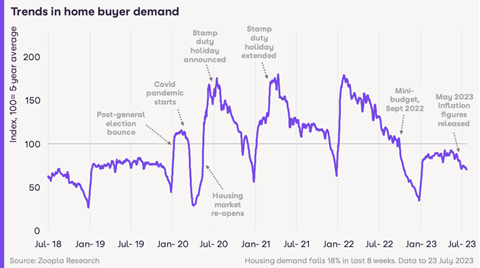Annual house price growth slowed to just over half a percent with the biggest declines in growth in the London commuter belt
Higher mortgage rates have reduced demand for homes by 18% nationally in the past two months, according to the latest Zoopla data.
Borrowing costs began to rise from mid-May 2023 when it became clear that inflation wasn’t dropping as quickly as had been forecast. In June, the Bank of England increased the base rate to 5%, resulting in mortgage rates of above 6%.
In the last eight weeks, sales of three or four-bedroom homes fell by 41% and demand for property across the board declined nearly 20%. Year-on-year buyer demand has dropped 40%, according to Zoopla’s House Price Index.
The combined impact of lower buyer demand and higher supply have driven a rapid slowdown in house price growth, according to the property portal.
Annual UK house price growth is now 0.6% compared to 9.6% in June 2022. This is broadly in line with Rightmove data which last week reported house price growth of 0.5% annually.

“Higher mortgage rates have hit homebuyer demand, but the impact is not uniform across the country,” Richard Donnell, executive director of research at Zoopla, said in a statement.
“Southern England is set to experience above-average price falls while some areas may not post any price falls at all.”
Areas with higher-than-average house prices are more exposed to price drops while some more affordable areas are experiencing significant growth.
The South East is leading on annual price falls, particularly around the London commuter belt regions of Southend (-1.5%), Watford (-1.2%) and Hertfordshire (-1.1%).
>> See also House sales ‘to drop 25%’ amid mortgage rate surge
>> See also Average mortgage cost tops post mini-Budget high
House prices in London are falling but not dramatically across the region, while prices in West Central London are up 1% year-on-year.
More affordable areas around the country are less exposed to the impacts of higher borrowing.
In some areas of North England house prices are up dramatically, such as in Halifax (+4.3%) and Wolverhampton, where growth is over 3.7%, year-on-year.
However, prices are down around 1% in Sunderland, Aberdeen and Northern Ireland.
Last week analysts suggested that the cost of borrowing may have peaked, following the release of lower-than-expected inflation figures.











No comments yet